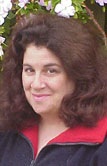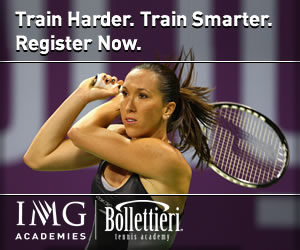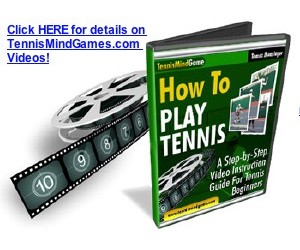April 2005 Article Tennis Server
|

 |
Along with better tennis weather, Spring is science fair time in the United States and our editor-in-chief, Dr. Cliff Kurtzman, suggested a column on tennis science fair projects. Most educators, from elementary school to the major universities, encourage students to pick a topic of interest. Conducting a tennis science project is a great way for a young player to learn more about the sport while fulfilling a classroom requirement. They'll learn some science and math and also have some fun. In this column we'll provide some tennis science fair project ideas, information on how to conduct experiments, helpful hints and note a few common experiment pitfalls. While suggestions are made for high school students, the column focuses on experiments for elementary and middle school students.
Tennis Players Are "Natural" Experimenters
Let's take a different example. Maybe you like paper airplanes. You fold one and play - you actually "experiment" with it. What happens if you bend one wing down and not the other? What if you add some weight to the nose or tail with a paper clip? How does the plane react? You may not have recognized this before, but there is a lot of natural experimentation when you "play."
Selecting A Topic - Forming A "Hypothesis"
One way to come up with a topic is to start asking the following questions: "What," "How," "How Much," "Which." Watch a professional match. Watch your friends play. Observe your own game. Bounce or throw a tennis ball. Look at different courts or tennis equipment. Do you have any questions about these? How does the first serve differ from the second serve? Is it typically faster or slower? How much faster or slower? Which is better - lose or tight strings? (And what does "better" mean? More control? More power?) What would happen if the tennis ball didn't have fuzz on it? Do all balls bounce the same? What makes a ball go faster on a return: a lighter racket, a stiffer racket, tighter strings or a faster racket head speed? If one of your friends always gets their first serve in and another friend doesn't - what are your friends doing differently? How can you determine an answer to these questions? Most often this entails setting up a repeatable situation where only one factor is varied at a time. For example, the question may be "Does a ball bounce differently on a grass court versus a hard court?" You could launch the same ball, with the same ball machine, set to the same spin and speed located at the same court position on a grass court and then a hard court on a day with no wind. Thus, the only variation is the court. You'll often read that you must have a "hypothesis" to prove when you conduct research; that is not necessarily true. There are forms of research that are exploratory in nature that do not have to be proved. So sometimes it is simply more applicable to state that you are investigating or studying a subject.
Here are some links to some tennis science projects that might be helpful: Tennis Sport Science Lesson Plans, Tennis Sport Science Curriculum Links, and from the Society of Women Engineers - Motion Math and Motion Capture and Analysis. Another is the ball bounce experiments in the September, October and November 2002 Tennis Server columns.
Planning Your Project
The Recipe
When you conduct your experiment you will need supplies (ingredients) and tools. You'll also need a list of instructions that you will use to get you from Point A (the raw ingredients) to Point B (the finished product - the MONSTER CHOCOLATE CAKE).
The Budget - Your Money and Time
Sometimes there are lots of "hidden costs" in a project. Remember the recipe? The ingredients asked for "1 cup of sugar" and "1 teaspoon of sugar." Okay, you'll need to buy or have on hand sugar and vanilla. The hidden costs may be the "tools." Do you have a measuring cup and teaspoon? Careful planning to identify these hidden costs will help you here! To reduce costs you may want to borrow what you can or see what you have around the house that you can use. You may also be able to get samples or scrap items from businesses, if you let them know that it is for a school project. So, as part of your plan you will need a materials list. What do you need: new tennis balls, poster board, colored markers, tape measures, film, a video camera? Some of these things you may need to buy; others you can possibly borrow. List everything; add up how much these items will cost. It may be more than you expected. DON'T PANIC! Look at it again! Do you really need everything? Can you borrow any of the items? Can you substitute something that you have readily available for something else on your list? You will be surprised how clever you become when your budget is tight! Planning your time is important for another very practical reason. You want to be able to finish your project on schedule and enjoy it as much as possible. Have you ever been in a situation where at the last minute something went wrong and you didn't finish your homework on time? Or maybe you just waited until the last minute and didn't give yourself enough time to do a science fair project. Not only do you feel disappointed, but sometimes you just feel so rushed! You promise yourself - "next time I'm going to start earlier." Here's a few tips: 1. Try and work on your project at least a little bit everyday. Even if you don't make much progress you are still farther along then you were yesterday. 2. Try and write your report as you go along; or write what you accomplished everyday in a journal. Writing your report as you conduct your project will help reduce the amount of work you have to do in those last days of your project. It also serves as a reminder of "where you left off" if you can't work on your project everyday.
The Blueprint - Your Instructions
Test plans or scripts are a great way to have others review and critique your work. For example, before our team went to the USTA training center to conduct these experiments, we were asked to document what we would be doing and submit that documentation for the USTA sports scientists to review. We were all set! We simply sent the USTA our test scripts. Having these instructions serves multiple purposes:
Pitfalls
I believe that the biggest pitfall is when students either knowingly or accidentally vary too many of the science experiment's parameters at one time. Sometimes tennis projects require the ball to be launched in the same manner every time. Sometimes students want to hit the ball themselves, hoping that they will hit the ball the same each time. Of course, this is very difficult to do and judges and teachers also will question if you were really successful. One alternative is to use a ball machine. Another is to make a ball "slingshot"- the slingshot is hammered into the ground and the "sling" pulled back to the same position each time. Another common pitfall is changing too many things in your experiment so that you cannot determine the "cause and effect." Let's examine a serve experiment. You decide that part of your experiment will be to see how your friend serves with different rackets. Perhaps some are heavier than others. Perhaps some of the rackets you test are strung tighter or loser than others. Your friend tests the different rackets and you see that they do better with a couple of different rackets - but there is no real pattern. How will you make your conclusion? Sure you can say your friend did better with Brand XYZ strung at ABC number of pounds - but why did they do better with the racket? You have had too many "variables" in your experiment. First of all, your friend is not a machine. Not every serve will be hit with the same exact stroke pattern and power. Your friend gets tired after a while, also. By using different rackets strung differently you may also have added too many variables (changes) into the picture. Perhaps, instead you could start with one racket and have it strung differently and compare the results. (This is still a really difficult experiment to analyze because of the "human factor"). Another common mistake made is defining an experiment that cannot prove the point that you want to make.
Analysis
Consequently, your analysis could include: This is also an area where experience is important. Students should not hesitate to review their results with parents, teachers, a coach or other person they feel can shed light on the interpretation of their results. Professional researchers, scientists and engineers very often have their colleagues review their results.
Favorite Experiments For middle school students I think examining ball bounce angles on different types of courts is a great experiment (see September, October and November 2002 Tennis Server columns) and for high school students I think tennis biomechanics experiments are appropriate. Good luck with your project and let me know how it goes. Until Next Month ... Jani
This column is copyrighted by Jani Macari Pallis, Ph.D., all rights
reserved.
Dr. Jani Macari Pallis is the founder and CEO of Cislunar Aerospace,
Inc., an engineering and research firm in San Francisco. In addition
to her engineering practice, she has led two collaborations between
NASA and Cislunar, creating educational materials on the aerodynamics
of sports for pre-college students and educators. As the head of
NASA's "Aerodynamics in Sports" project, she has led a team of
researchers investigating the aerodynamics, physics and biomechanics
of tennis. The group has conducted high speed video data capture at
the US Open and research of ball/court interaction, footwork, serve
speeds, trajectories and ball aerodynamics. Pallis received a BS and
MS from the Georgia Institute of Technology, an MS in mechanical
engineering from the University of California, Berkeley and a Ph.D.
in mechanical and aeronautical engineering from the University of
California, Davis. She is a member of the Executive Committee of The
International Sports Engineering Association.
Questions and comments about these columns can be directed to Jani by
using this form.
|



October 2022 Tennis Anyone: Patterns in Doubles by John Mills. September 2022 Tennis Anyone: Short Court by John Mills. |
 You will join 13,000 other subscribers in receiving news of updates to the Tennis Server along with monthly tennis tips from tennis pro Tom Veneziano.
You will join 13,000 other subscribers in receiving news of updates to the Tennis Server along with monthly tennis tips from tennis pro Tom Veneziano. 

